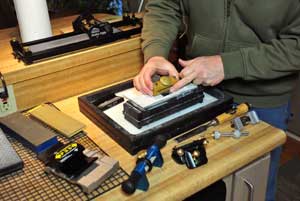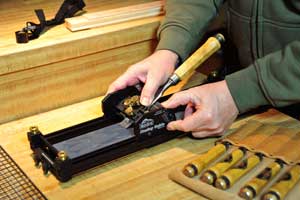 I’ve never been particularly adept at sharpening my edge tools (chisels, plane irons, etc.). It’s not that I couldn’t get them sharp enough to work, it’s just that I’ve always experienced inconsistent results. One time, I’d get a blade so sharp, it simply glided through hard oak and maple. The next time I sharpened that blade, I’d be lucky if it didn’t tear its way through soft pine. Freehand sharpening always seemed like something that would take decades to get right (an opinion no doubt influenced by the fact that the best tool sharpener I know has made nearly 95 trips around the sun). The trick seems to be locking your wrists and fingers as you pass the tool over the stone, to keep the honing bevel at the same angle during every pass. Fail this, and you end up with a rounded bevel face and an edge that’s none too sharp. Yes, hollow grinding helps, as the tip and heel of the bevel are easier to keep flat on the stone. But unless the tool has a wide bevel, like a big chisel or heavy plane iron, even hollow grinding is no guarantee.
I’ve never been particularly adept at sharpening my edge tools (chisels, plane irons, etc.). It’s not that I couldn’t get them sharp enough to work, it’s just that I’ve always experienced inconsistent results. One time, I’d get a blade so sharp, it simply glided through hard oak and maple. The next time I sharpened that blade, I’d be lucky if it didn’t tear its way through soft pine. Freehand sharpening always seemed like something that would take decades to get right (an opinion no doubt influenced by the fact that the best tool sharpener I know has made nearly 95 trips around the sun). The trick seems to be locking your wrists and fingers as you pass the tool over the stone, to keep the honing bevel at the same angle during every pass. Fail this, and you end up with a rounded bevel face and an edge that’s none too sharp. Yes, hollow grinding helps, as the tip and heel of the bevel are easier to keep flat on the stone. But unless the tool has a wide bevel, like a big chisel or heavy plane iron, even hollow grinding is no guarantee.
Speaking of guarantees, I finally found one for sharpening: Using a honing guide. These devices hold a blade at a reliably accurate angle and can, indeed, repeatably produce razor-sharp edges on all your chisels and plane irons. Such guides have existed for a long time; I remember seeing the English-made Eclipse guide in woodworking catalogues a handful of decades ago. But I always thought these were just gadgets that desperate woodworkers bought when they got fed up with their own failed sharpening attempts (I guess I never got desperate enough…).
Boy, was I wrong. Currently, I’m right in the middle of checking out nine different honing guides on the market. These range from the latest iterations of the  Eclipse-style side-clamping guide, which sells for less than $15., to the innovative (if pricey at $170) “Sharp Skate III.” Some of these guides, such as the Veritas honing guides made in Canada by Lee Valley Tools, come with their own angle registration jigs, designed to make it easy to set a blade to an accurate bevel angle. Others, like the M-Power PSS and Pinnacle honing guides, are part of systems that come with their own sharpening media .
Eclipse-style side-clamping guide, which sells for less than $15., to the innovative (if pricey at $170) “Sharp Skate III.” Some of these guides, such as the Veritas honing guides made in Canada by Lee Valley Tools, come with their own angle registration jigs, designed to make it easy to set a blade to an accurate bevel angle. Others, like the M-Power PSS and Pinnacle honing guides, are part of systems that come with their own sharpening media .
One of the things I love about this collection is that most of these guides are very different from one another, so comparing them is rather an apples-and-oranges affair. I’ll be sharing all my observations and opinions in an upcoming issue of the Woodworker’s Journal. But until then, I’ll tell you this: All the guides have advantages as well as quirks and limitations. But, once you get used to them, each is capable of producing a smokin’ sharp edge. The best news for me is that, after weeks of testing, the edge tools in my shop can now produce shavings so clean and paper thin that you can practically see through them!
Sandor Nagyszalanczy







